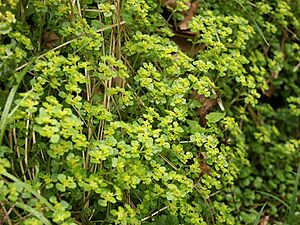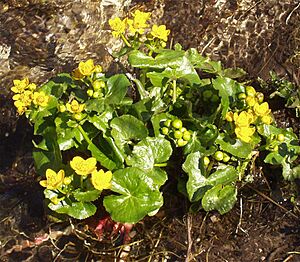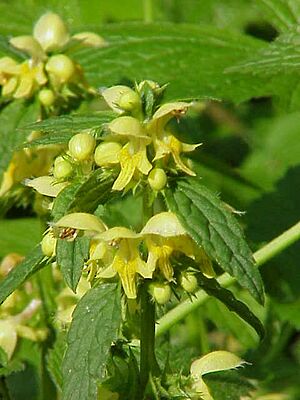Trodds Copse facts for kids
| Site of Special Scientific Interest | |
| Area of Search | Hampshire |
|---|---|
| Grid reference | SU417224 |
| Coordinates | 50°59′55″N 1°24′22″W / 50.99858°N 1.40612°W |
| Interest | Biological |
| Area | 25.23 hectares |
| Notification | 1989 |
Trodds Copse is a special natural area in central Hampshire, England. It covers about 25 hectares, which is like 35 football fields! This place is so important that it was named a Site of Special Scientific Interest (SSSI) in 1989. An SSSI is a protected area because it has rare plants, animals, or unique land features. Trodds Copse has very old woodlands, natural meadows, and wet, boggy areas called flushes.
Contents
Where is Trodds Copse Located?
Trodds Copse is found northwest of Chandler's Ford. It sits between Flexford Road and Hook Road. The area also borders the Eastleigh to Romsey railway line.
What Makes Trodds Copse Special?
Trodds Copse is a truly amazing place for nature. It has ancient woodlands that have been around for hundreds of years. It also features untouched meadows and wet, marshy spots. The ground here is a mix of different types of soil, like sand and peat. This variety in the ground helps many different kinds of plants grow.
The area is also drained by small streams that flow into the Monks Brook. This brook eventually joins the River Itchen. Because of the different soil types and water conditions, Trodds Copse has many unique habitats. Scientists have found at least ten different types of woodland here. Four of these woodland types are considered very rare across the country!
The ground is full of a huge variety of plants. Many of these plants are "ancient woodland indicators." This means they only grow in very old, undisturbed forests. Over 50 such species have been found here. Some rare local plants, like tutsan, also grow in Trodds Copse. This makes it one of the richest places for plants in all of Hampshire.
A Look Back in Time: History of Trodds Copse
People have known about Trodds Copse for a very long time. Records show it has been documented since the late 1500s. Before 1588, this whole area was common land. This means everyone could use it. Later, it was "enclosed," meaning it became private land. You can still see old banks that marked the woodland boundaries from that time.
Some parts of the copse were once used for "wood pasture." This is where trees were grown for wood, and animals grazed among them. But by the early 1800s, this practice stopped. The land was then used for regular pasture or for growing trees that were cut back regularly (called coppice woodland).
Today, Trodds Copse faces a challenge from new buildings. The town of Chandler's Ford is growing towards the northwest. In 1990, there was a plan to build 200 houses and a golf course nearby. This plan was stopped because it would have harmed Trodds Copse. The area was recognized as an important "Countryside Heritage Site."
Amazing Plants of Trodds Copse
Trodds Copse is home to a wide variety of trees and plants. Here are just a few examples:
- Maple (Acer campestre)
- Alder (Alnus glutinosa)
- Common Hazel (Corylus avellana)
- Alder buckthorn (Frangula alnus)
- Common Ash (Fraxinus excelsior)
- Pedunculate Oak (Quercus robur)
- Rowan (Sorbus aucuparia)
- Sneezewort (Achillea ptarmica)
- Velvet bent (Agrostis canina)
- Tall oat (Arrhenatherum elatius)
- Marsh marigold (Caltha palustris)
- Brown sedge (Carex disticha)
- Smooth-stalked sedge (C. laevigata)
- Tussock sedge (C. paniculata)
- Remote sedge (C. remota)
- Opposite-leaved golden saxifrage (Chrysosplenium oppositifolium)
- Purple loosestrife (Epipactis purpurata)
- Meadowsweet (Filipendula ulmaria)
- Marsh bedstraw (Galium palustre)
- Fen bedstraw (G. uliginosum)
- Water avens (Geum rivale)
- Ivy (Hedera helix)
- Yorkshire fog (Holcus lanatus)
- Tutsan (Hypericum androsaemum)
- Sharp-flowered rush (Juncus acutiflorus)
- Yellow archangel (Lamiastrum galeobdolon)
- Honeysuckle (Lonicera periclymenum)
- Gipsywort (Lycopus europaeus)
- Yellow loosestrife (Lysimachia vulgaris)
- Cyclamen-flowered Daffodil (Narcissus cyclamineus)
- Bramble (Rubus fruticosus)
- Wood club rush (Scirpus sylvaticus)
- Bog mosses, including:
- Sphagnum palustre
- S. flexuosum
- Sphagnum recurvum var. mucronatum
- Devil’s bit scabious (Succisa pratensis)
- Branched bur-reed (Sparganium erectum)
Cool Creatures of Trodds Copse
The many different habitats at Trodds Copse also mean it's home to a wide range of invertebrates. Invertebrates are animals without backbones, like insects. Here are some of the interesting ones found here:
- Hoverfly (Criorhina asilica)
- Robber fly (Choerades marginatus)
- Solitary bee (Macropis europaea)
- Tachinid fly (Phasia hemiptera)
- Hoverfly (Volucella inflata)





